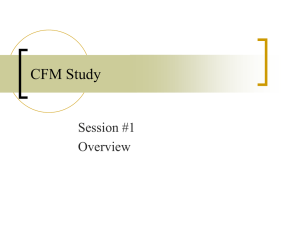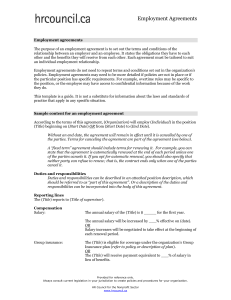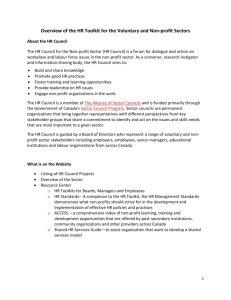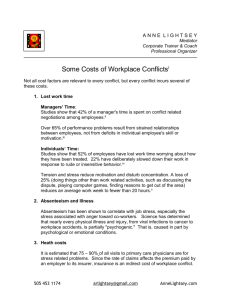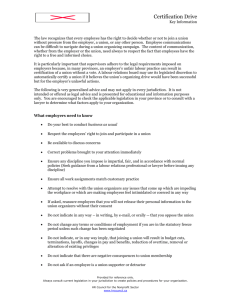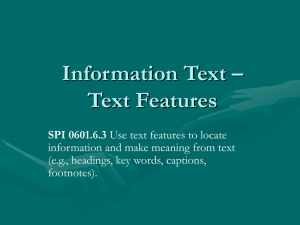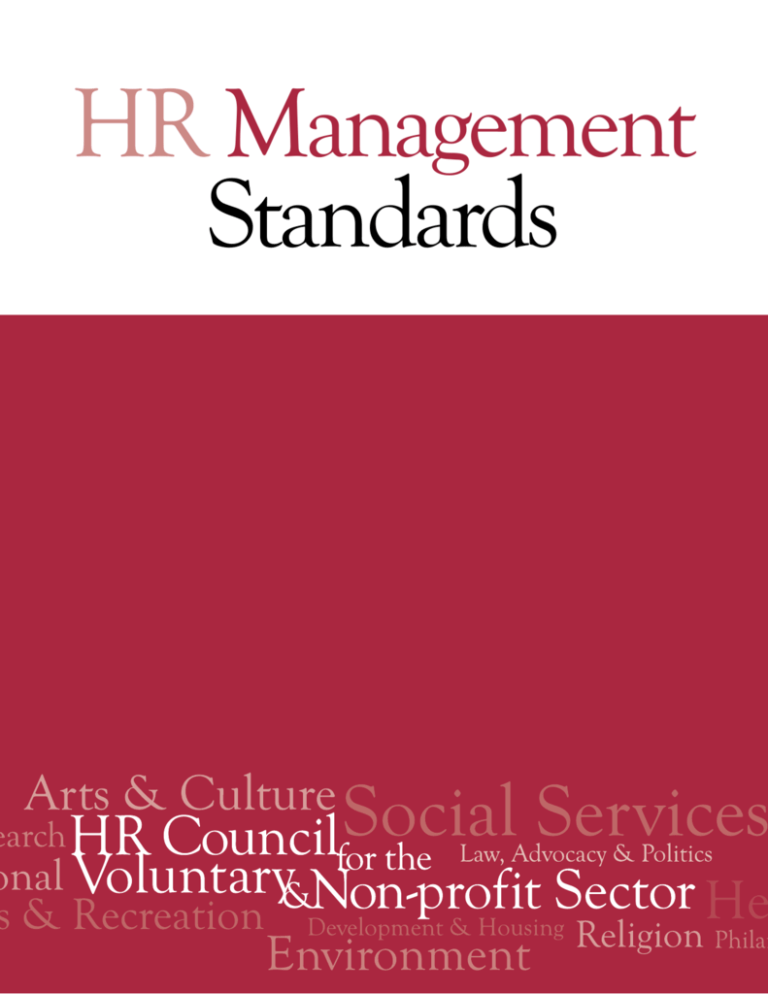
HR Management
Standards
The HR Council for the Voluntary & Non-profit Sector (HR Council) works with organizations,
educators, labour and government to identify and address issues related to paid employment
in the voluntary and non-profit sector.
Our priorities are to:
• Build and share knowledge
• Promote good HR practices
• Foster training and learning opportunities
• Provide leadership on HR issues
• Engage voluntary and non-profit organizations in our work
© 2009 HR Council for the Voluntary & Non-profit Sector
All rights reserved. The use of any part of this publication, whether it is reproduced, stored in a retrieval
system, or transmitted in any form or by any means (including electronic, mechanical, photographic,
photocopying or recording), without the prior written permission of the HR Council is an infringement
of copyright law.
Disclaimer
The content of this HR Management Standards publication (“Standards”) is provided for information
purposes only and does not constitute legal advice. No legal liability or other responsibility is accepted by
or on behalf of the HR Council or its members, officers, employees or advisors for any errors, omissions,
or statements contained in the Standards. The HR Council accepts no responsibility for any loss, damage
or inconvenience caused as a result of reliance on the Standards.
Aussi disponible en français.
201-291 Dalhousie Street | Ottawa, Ontario K1N 7E5
613.244.8332 | TF: 866.594.8332
info@hrcouncil.ca
The HR Council is funded through the Government of Canada’s Sector Council Program.
The opinions and interpretations in this publication are those of the author and do not
necessarily reflect those of the Government of Canada.
Contents
1 Introduction
1
2 Standards
5
how the standards were developed
Principles
Target Audiences
Terminology
HR Management Standards Overview
1. HR Management Policy Framework and Employment Legislation
2. Getting the Right People
3. Managing People and their Work
4. Workplaces that Work
5. Training, Learning & Development
6. HR Planning
3 Implementing Standards
Role of the Governing Authority
4 Appendices
Appendix I: Self-Assessment Guide
Appendix II: Advisory Committee Members
Appendix III: Organizations Participating in Validation Sessions
2
2
3
3
4
6
8
12
16
19
22
24
25
26
29
30
1 Introduction
Each
organization
will need to
consider how
the Standards
can be adopted
to reflect their
organization’s
available
resources.
O
rganizations in the non-profit sector are increasingly challenged by the
same HR issues as organizations in other sectors – an aging workforce,
falling recruitment levels and rising skills requirements. However many boards
and managers in our sector lack the skills, tools and resources to address these
challenges. Many are seeking resources and support in relation to their human
resource management responsibilities.
The HR Management Standards (Standards) developed by the HR Council
for the Voluntary & Non-profit Sector (HR Council) are intended to inspire,
educate and support board members, managers and employees with regard to
the fundamental role HR management policies and practices have in creating
effective organizations. The Standards are designed and presented in such a
way as to assist non-profit organizations in developing effective HR management policies and practices.
The diversity of organizations in the non-profit sector and the significant
variations in how organizations are structured and funded means that the
Standards will not uniformly fit every organization. Each organization will need
to consider how the Standards can be adopted to reflect their organization’s
available resources, such as expertise, available time and priorities, yet at the
same time achieve the overall intent underlying the Standards. Organizations
can work towards achieving these Standards in ways that are appropriate to
their operations and which consider the resources available to them.
Organizations can use these Standards to:
1. Examine their current policies and practices
2. Determine what needs to be changed, and then
3. Determine how the Standards can be used to improve the organization’s
policies and practices in order to enhance the organization’s performance.
Balance is required; standards need to address current issues confronted
by non-profit organizations; however there also must be a focus on the future.
As evident in Toward a Labour Force Strategy for Canada’s Voluntary & Non-profit
Sector1, organizations in the sector are influenced by circumstances in the
1 Available at http://www.hrcouncil.ca/projects/council-projects-sector.cfm
HR Management Standards
| 1
external environment such as high labour market
demands in other sectors that compete with the
ability of non-profit organizations to recruit and
retain staff. Non-profit organizations need to consider these Standards as they develop appropriate
policies, processes and practices to address
such challenges.
Principles underlying the Standards and potential target audiences are identified in order to
deepen the understanding of organizations as to
how Standards can be used.
The Standards are grouped into
six broad clusters:
•
HR Management Policy Framework &
Employment Legislation
•
Getting the Right People
•
Managing People and their Work
•
Workplaces that Work
•
Training, Learning & Development
•
HR Planning
Each cluster of Standards has five parts:
1. Introductory statements that identify the intent
and benefits of achieving the standards within
that cluster.
How the standards
were developed
In 2008, the HR Council convened an Advisory
Committee2 composed of individuals from across
Canada involved in providing HR management
services to organizations in the sector. Working
with a consultant, the Advisory Committee
reviewed research3 that identified the key features
and structures to relevant standards programs in
Canada and the US. The research provided a basic
framework to undertake developing a series of
HR management standards.
Once a draft set of standards was developed,
three validation sessions were held in Toronto,
Regina and Halifax to solicit feedback from
37 individuals representing a variety of organizations.4 Using the feedback, the HR Management
Standards were revised and the Advisory
Committee met to review the revised standards
and offer final comments.
Principles
The following principles articulate the broad framework and intent of the Standards and guided the
development of the specific standards:
•
Reinforce compliance with legal requirements.
Being compliant with relevant legislation is the
absolute minimum standard that organizations
must achieve. The Standards reinforce compliance but also provide a rationale as to why organizations should do more than the minimum.
•
Support active and positive approaches to working with employees. Rather than being reactive
to continuing problems, the Standards provide
managers with information to establish processes and practices that encourage and support
employees in their current and future work.
2. The Standard statement itself that summarizes
the end result to be achieved.
3. Standard Details that provide detail on what
to include when considering how to achieve
the standard.
4. Implementation Considerations that includes
information to help in implementation as well
as connections between Standards and/or other
operations within the organization.
5. Links to Resources that provides links to articles, research documents, tools or templates to
assist in achieving the Standards.
2 See Appendix 2 for a list of Advisory Committee members and consultant
3 See Human Resource Management Standards/Guidelines August 1, 2008
4 See Appendix 3 for a list of individuals and organizations who participated in the validation sessions
HR Management Standards
| 2
•
•
•
•
Contribute to a fair and equitable work
environment. The Standards set the stage for
developing processes that are clear, known and
applied consistently so that expectations in performance and relationships essential to an effective workplace are established and promoted.
Integrate with standards that support organizational excellence in governance and accountability. HR management practices do not function in
isolation, but are part of the organization’s overall
approach to interacting with the public, funders,
volunteers and other organizations. These HR
Management Standards must be integrated with
other standards, such as good governance, ethical
fundraising and financial accountability.
Act as a foundation for individual learning and
organizational improvement. The Standards
support organizations in identifying areas for
improvement and to make a clear link between
employee performance and organizational results.
Provide tools that will build organizational
effectiveness. By implementing the Standards,
organizations make a demonstrable commitment
to excellence and allocating resources to ensure
capacity is built and sustained and that their
mandate is accomplished.
Target audiences
Primary target audiences who can benefit from the
Standards include:
•
Organizations in assessing and evaluating their
current HR management policies and practices,
identifying gaps and developing solutions to fill
those gaps.
•
Management staff in identifying where their
skills and knowledge to implement effective
HR management policies and practices may be
limited or missing.
•
Boards by providing clear direction on their role
in this critical area as well as criteria to ensure
the organization’s HR management policies and
practices are implemented thoroughly
and effectively.
•
Current and future employees in assessing how
the organization supports their work and career.
•
Donors and funders in determining which
organizations have effective HR management
policies and practices and supporting organizations in developing and implementing effective
HR management policies.
•
Partner organizations in gauging the sustainability and effectiveness of their partners.
•
Organizations that provide capacity building
activities to non-profit organizations to support
implementation of effective HR management
policies and practices.
•
The public and community by providing a clear
link to understand how a non-profit organization
works with their employees to achieve results.
Terminology
Employee
Is used generically throughout this document to
apply to all paid staff of the organization whether
full-time, part-time, fixed-term contract, salaried or
hourly. This would include all management employees but exclude all individuals volunteering their
time with the organization.
Governing Authority
Refers to the formal body with highest authority
within the organization. In most cases this will be a
board of directors of the legal entity, or a governing
committee of volunteers to whom the most senior
staff person reports.
Most Senior Staff Person
The highest ranking paid employee in the organization to whom all other employees report either directly or indirectly, and who reports to the Governing
Authority. In most cases this will be an Executive
Director or Chief Executive Officer (CEO).
Position
Refers to a role or job that is filled by
an employee.
HR Management Standards
| 3
HR Management Standards Overview
1. HR Management Policy Framework and Employment Legislation
1.1 HR management policies are formalized, documented and approved by the appropriate authority.
1.2 HR management policies comply with employment, workplace health and safety, and other related
legislation as applicable in the jurisdiction in which the organization operates.
1.3 HR management policies are reviewed on a regular basis and revised, if necessary.
2. Getting the Right People
2.1 An approved job description is completed for all positions.
2.2 Recruitment is through an objective, consistent process.
2.3 Criteria used to select the appropriate individual are established and documented.
2.4 All individuals external to the organization who are offered a position sign a letter of employment
that outlines the working relationship between the individual and the organization.
2.5 All new employees are oriented to the position and to the organization.
2.6 Plans are documented to address any potential key employee turnover so that the organization’s
clients and public continue to receive programs and services.
3. Managing People and their Work
3.1 Managers and supervisors with the responsibility for managing the efforts of others are provided
with appropriate learning opportunities to develop their supervisory skills.
3.2 All employees have a work plan and performance objectives that identify the tasks/activities and
expected results for future performance.
3.3 The performance of each employee is fairly assessed, at least annually, at the end of the work plan
or performance period.
3.4 The organization’s performance management process includes the potential for coaching
employees in order to address performance issues/concerns.
3.5 The organization provides competitive compensation to employees.
4. Workplaces that Work
4.1 The organization is committed to providing a safe work environment.
4.2 The organization is committed to supporting employee work/life balance.
4.3 The organization ensures a work environment free of harassment.
4.4 The organization is committed to promoting an inclusive workplace.
4.5 The organization has established procedures and informed employees with regard to how to resolve
conflicts within the organization.
5. Training, Learning & Development
5.1 Every employee’s training and development needs are reviewed at least annually and plans
established to address any gaps.
5.2 During the development of the annual budget, consideration is given to including appropriate
resources to fund employee training and development..
6. HR Planning
6.1 The organization has a process to review staffing needs resulting in a plan to address those needs.
6.2 Critical positions in the organization are identified and succession plans are established to address
any potential gaps.
HR Management Standards
| 4
2 Standards
HR Management Standards
| 5
1. HR Management Policy Framework & Employment Legislation
The intent of HR management policies is to create a workplace where:
•
•
•
•
•
It can be assured that minimum legal requirements are being met
Best practices appropriate to the organization can be documented and implemented
Management decisions and action are consistent, uniform and predictable
Individuals and the organization are protected from the pressures of expediency
Organization values are promoted
In developing HR management policies, organizations will likely have practices that can be reviewed and converted into policies. All
employers, including those in the non-profit sector, must comply with federal and/or provincial legislation relating to employment and
workplaces, therefore HR management policies and practices must take into account the relevant laws and regulations. While legislation
provides the framework, the interpretation of legislation will be through case law – both legislation and case law will need to be referenced
for a complete picture of what is required of employers.
Standard 1.1
HR management policies are formalized, documented and approved by the appropriate authority.
STANDARD DETAILS
IMPLEMENTATION CONSIDERATIONS
Links to Resources
HR management policies are formal written documents
easily accessible by management, employees and
key stakeholders.
Policies can be hard copy or electronic copy.
Information on developing HR
policies as well as sample policies are
available at:
Policies should include those issues that govern the work
and actions of employees, such as:
• Conflict of interest
• Working conditions
• Compensation and benefits
• Vacation and sick leave
• Termination by employer
• Performance management
• Staff development
• Harassment
• Conflict resolution
• Formal complaint process
• Processes to review/update policies
• Confidentiality
Consideration can be given to providing the governing
authority with a report on how policies are applied and
any revisions that are being considered to the policies.
Refer to the following Standards:
Standard 3.3
Standard 5.1
Standard 4.3
Standard 4.5
www.hrcouncil.ca/hr-toolkit/policies-overview.cfm
Templates are available at:
www.hrcouncil.ca/hr-toolkit/resources-resources.cfm
•
•
Sample Employee Handbook
Sample Policies on Common
HR Topics
HR Management Standards
| 6
R management policies comply with employment, workplace health and safety, and other related legislation as applicable in the
Standard 1.2 Hjurisdiction
in which the organization operates.
STANDARD DETAILS
IMPLEMENTATION CONSIDERATIONS
Links to Resources
A periodic review of relevant legislation is conducted
to ensure compliance.
At a minimum, legislation reviewed should include
the following:
• Employment/Labour Standards
• Privacy legislation
• Occupational Health and Safety
• Human Rights
• Workers Compensation
An overview with additional links to
employment-related legislation:
A written report documenting compliance is
submitted to the organization’s governing authority
at least annually
www.hrcouncil.ca/hr-toolkit/policies-overview.cfm
It is not feasible to identify all legislation that needs to
be considered; some legislation is provincial while other
legislation is federal.
Organizations also need to be aware of how legislation
may, periodically, be applicable to their workplace, such
as provisions for releasing staff to vote on election day
or legislation relevant to organizing a union.
Depending on the internal expertise available to the
organization, it may be appropriate to seek external
assistance to ensure HR management policies comply
with relevant legislation.
Standard 1.3
HR management policies are reviewed on a regular basis and revised, if necessary.
STANDARD DETAILS
IMPLEMENTATION CONSIDERATIONS
HR management policies are reviewed annually to
ensure changes to employment-related legislation and/
or new developments in HR management best practices
are incorporated into the organization’s HR management policies.
Policies could be reviewed annually by the governing
authority in order to satisfy their responsibility that
the organization is operating in compliance with the
appropriate laws and regulations.
Links to Resources
Policies could be reviewed during a regular staff
meeting to gain input from staff as well as remind
staff of existing policies.
HR Management Standards
| 7
2. Getting the Right People
Recruiting individuals to fill positions is the most critical HR management function undertaken whether the person is being recruited from
within or outside the organization. Committed, motivated, and qualified employees will help an organization achieve its purpose and goals.
The recruitment process begins by defining the job, seeking a pool of qualified individuals, selecting the best individual for the position, and
finally orienting the individual to the position and to the organization (if the individual is hired from outside the organization).
When an organization hires, promotes or transfers an employee it is making a commitment to that person. As such, an organization is
obligated to ensure that the individual has all reasonable opportunity to perform the job satisfactorily; the goal is to recruit, select and orient
the most suitable individuals to the organization.
Standard 2.1
An approved job description is completed for all positions.
STANDARD DETAILS
IMPLEMENTATION CONSIDERATIONS
Links to Resources
Job descriptions may include:
• Typical duties, tasks, and responsibilities of
the position
• How the work of the position supports the goals of
the organization
• Minimum competencies/experience required to do
the work of the position including equivalencies to
address non-Canadian education/credentials
• Special requirements (if any) such as security clearance or criminal record checks
• Degree of authority and/or independence of
the position
• Impact of the position on the organization (such as
relationships the position is expected to maintain
with stakeholders and others)
Job descriptions document the tasks and activities
required of the position in order to fulfill the organization’s strategic and short-term objectives within the
current organization structure. The end result will
determine the types of skills and experiences required
of individuals in order to be successful in this role.
Information on developing job
descriptions is available at:
The job description is the foundation for both
performance management and knowledge
management activities.
www.hrcouncil.ca/hr-toolkit/right-people-jobdescriptions.cfm
Templates are available at:
www.hrcouncil.ca/hr-toolkit/resources-resources.cfm
•
•
Job Analysis Questionnaire
Template
Job Description Template
Refer to the following Standards:
Standard 2.1
Standard 3.3
Standard 5.2
If the workplace is unionized, job descriptions may need
to be negotiated, reviewed or shared with the union.
All job descriptions are reviewed annually to ensure that
they are aligned with the strategic direction and structure of the organization.
Job descriptions should be reviewed when there are
significant changes in the direction of the organization
and/or position.
Changes to job descriptions automatically trigger a review
of compensation rates.
Refer to Standard 3.5
HR Management Standards
| 8
Standard 2.2
Recruitment is through an objective, consistent process.
STANDARD DETAILS
IMPLEMENTATION CONSIDERATIONS
Links to Resources
The recruitment process is fair and objective so that candidates, whether internal or external, are being assessed
using the same criteria.
External recruitment of staff will likely involve a variety
of communication processes to inform other organizations and relevant communities-of-interest of the available position.
Additional information on recruitment
is available at:
Recruitment will comply with human rights legislation.
Internal recruitment will be linked to processes of succession planning, performance management, learning
and could potentially involve some form of job posting.
Refer to Standard 1.2
Standard 2.3
www.hrcouncil.ca/hr-toolkit/right-peoplerecruitment.cfm
Templates are available at:
www.hrcouncil.ca/hr-toolkit/resources-resources.cfm
•
•
Recruitment Checklist
Reference Check Questions
Criteria used to select the appropriate individual are established and documented.
STANDARD DETAILS
IMPLEMENTATION CONSIDERATIONS
Links to Resources
Treatment of information collected through the
selection process conforms with privacy legislation.
Staffing for permanent positions could include oral
interviews, written or other appropriate tests to determine competence.
Additional information on selection
processes is available at:
www.hrcouncil.ca/hr-toolkit/right-people-selection.cfm
Interview questions comply with human
rights legislation.
Refer to Standard 1.2
Templates are available at:
www.hrcouncil.ca/hr-toolkit/resources-resources.cfm
•
•
•
•
Interview Questions
Interview Rating Guide Template
Hiring Practices for Equity in
Employment – Interview Guide
PIPEDA Guide
HR Management Standards
| 9
ll individuals external to the organization who are offered a position sign a letter of employment that outlines the working
Standard 2.4 Arelationship
between the individual and the organization.
STANDARD DETAILS
IMPLEMENTATION CONSIDERATIONS
Links to Resources
The letter of employment is signed by the employee and
returned to the organization before the commencement
of work. The letter contains key information including:
• Start date
• Job title
• Starting salary or wage rate
• Hours of work
• Notice period for resignation
• Notice period for termination
• Probationary terms
• Directions on accepting the offer
• Requirements for criminal record checks, security
clearances, bonding, etc.
• Key employee benefits
• Any special conditions of the position or offer
• Any accommodation needs as agreed during the
recruitment process
• Reporting/supervision relationships
• Information on the organization’s human resource
management policies and confirmation that
employees must adhere to them
• The end date of employment should be included
in the letter of employment for fixed term positions (such as project funded positions or filling a
maternity leave)
• Reference to union status (if applicable)
The letter of employment is a legal document and
should be treated as such.
Templates are available at:
A personnel file for each individual hired should be
maintained; the file should include the letter of employment and documentation of any subsequent changes to
the terms and conditions of employment.
www.hrcouncil.ca/hr-toolkit/resources-resources.cfm
•
•
Employment Agreement Template
Offer Letter Template
The current job description for the position could be
attached to the letter of employment, for information.
HR Management Standards
| 10
Standard 2.5
All new employees are oriented to the position and to the organization.
STANDARD DETAILS
IMPLEMENTATION CONSIDERATIONS
Links to Resources
Orientation may include information on:
• HR management policies
• Employee benefits and any documentation
explaining benefits
• The organization’s mission
• The governing, management &
reporting structures
• The funding structure
• The organization’s programs and services
• Expectations of the position over 3 months,
6 months and 1 year
• Resources available to support the position
• Respective roles and responsibilities of volunteers
and staff
Appropriate orientation early in an employee’s employment has been shown to enhance the early and ultimate
performance levels of new hires as well as build commitment to the position and to the organization.
Additional information on orientation
processes is available at:
Orientation is a process rather than an activity;
depending on the position, orienting a new employee
may take up to a year.
Templates are available at:
www.hrcouncil.ca/hr-toolkit/right-peopleorientation.cfm
www.hrcouncil.ca/hr-toolkit/resources-resources.cfm
•
Orientation Checklist
lans are documented to address any potential key employee turnover so that the organization’s clients and public continue to receive
Standard 2.6 Pprograms
and services.
STANDARD DETAILS
IMPLEMENTATION CONSIDERATIONS
Links to Resources
Key positions are identified that require ‘backup’ to
ensure continuation of service. Short term and long
term plans are in place to address potential gaps in these
key positions.
Refer to Standard 3.3
Information on succession planning is
available at:
The annual review of performance management results
could identify employees capable of assuming responsibilities of other positions.
www.hrcouncil.ca/hr-toolkit/planning-succession.cfm
HR Management Standards
| 11
3. Managing People and their Work
A fundamental of good management is that all employees know what to do, how well they are performing and what they need to learn in
order to do a better job. Setting clear performance targets and expectations, ensuring employees get objective feedback on their
performance and have a personal development plan, will drive more effective individual behaviour and enhance organization performance.
Building workplace relationships supports commitment by staff to the organization and to their work. These Standards will help to build a
work environment that encourages individual excellence and satisfaction balanced with the needs of the organization.
anagers and supervisors with the responsibility for managing the efforts of others are provided with appropriate learning
Standard 3.1 M
opportunities to develop their supervisory skills.
STANDARD DETAILS
IMPLEMENTATION CONSIDERATIONS
Links to Resources
Learning may include a variety of options including
coaching, mentoring, job shadowing etc. as well as
structured training sessions.
Information on the role and
functions of the manager/supervisor
is available at:
www.hrcouncil.ca/hr-toolkit/keeping-peoplesupervision.cfm
ll employees have a work plan and performance objectives that identify the tasks/activities and expected results for
Standard 3.2 Afuture
performance.
STANDARD DETAILS
IMPLEMENTATION CONSIDERATIONS
Links to Resources
The work plan or performance objectives (usually
annual) reflect the organization’s strategic direction,
business plans, and/or annual plans.
Creating a work plan/performance objectives is a
joint responsibility of both the employee and his/her
supervisor. Supervisors have final approval to ensure
work plans/performance objectives are integrated across
the organization and support the overall goals of the
organization.
Strategic and operation planning;
succession planning; risk management
is available at:
The work plan/performance objectives are written
documents jointly prepared by the employee and their
supervisor.
Work plans/performance objectives identify
individual development activities that support the
organization’s goals.
www.hrcouncil.ca/hr-toolkit/planning-overview.cfm
Templates are available at:
www.hrcouncil.ca/hr-toolkit/resources-resources.cfm
•
Workplan Template (2)
The supervisor needs to ensure that the work plan is
achievable given the time assigned to the position and
the skills of the individual.
HR Management Standards
| 12
Standard 3.3
The performance of each employee is fairly assessed, at least annually, at the end of the workplan or performance period.
STANDARD DETAILS
IMPLEMENTATION CONSIDERATIONS
Links to Resources
Performance reviews have clearly stated purpose(s)
which can include:
• Assessing the employee’s contribution to the
operational and strategic plan of the organization
• Assessing the degree of achievement related to his
or her workplan/objectives
• Encouraging performance excellence
• Identifying and addressing areas for improvement
in performance
• Identifying personal and professional
development needs
• Consideration for promotion or other work
assignments
• Identifying work and career goals
• Consideration for compensation increases
Performance management is an on-going process guided
by principles of positive HR management. At a minimum the policy should require a review at least annually, but an organization can choose to conduct more
frequent reviews.
Information on performance
management systems/processes
is available at:
Performance reviews are systematic; based on current
job descriptions and work plans.
Refer to the following Standards:
Standard 2.1
Standard 3.2
The performance review process and evaluation criteria
are established prior to any assessment and will be
known to both supervisor and employee.
Performance reviews are intended to give employees
clear feedback on their performance.
Performance reviews are intended to solve performance
problems early before the staff member’s performance
impacts negatively on the organization as a whole and/
or the individual’s continued employment.
www.hrcouncil.ca/hr-toolkit/keeping-peopleperformance-management.cfm
Templates are available at:
www.hrcouncil.ca/hr-toolkit/resources-resources.cfm
•
Performance Management
Form Template
If the workplace is unionized, performance management processes may need to be negotiated with
the union.
The performance review results in a written document
that has been reviewed and signed by both the employee
and his/her supervisor; the written document is filed in
the employee’s confidential personnel file.
Managers and supervisors responsible for assessing the
work of others are provided with an orientation to
conducting performance management reviews.
Refer to Standard 5.1
HR Management Standards
| 13
he organization’s performance management process includes the potential for coaching employees in order to address
Standard 3.4 Tperformance
issues/concerns.
STANDARD DETAILS
IMPLEMENTATION CONSIDERATIONS
Links to Resources
The aim of coaching should be to help the employee
address concerns and issues related to performance so
that there is a positive contribution to the organization.
Refer to the following Standards:
Standard 1.1
Standard 5.1
Information on the role and
functions of the supervisor is
available at:
Standard 3.5
www.hrcouncil.ca/hr-toolkit/keeping-peoplesupervision.cfm
The organization provides competitive compensation to employees.
STANDARD DETAILS
IMPLEMENTATION CONSIDERATIONS
Links to Resources
The organization’s compensation policy is designed and
implemented to provide internal equity amongst similar
positions within an organization, and ensures the organization is competitive in the marketplace as determined
by management and Governing Authority.
Depending on the organization’s strategic direction as
well as local labour market conditions, the benchmark
for a competitive compensation package may include
references to salary ranges or wage rates of comparable
positions in:
• Other organizations in the non-profit sector
• The public sector and/or
• The private sector.
Information on compensation and
benefits is available at:
www.hrcouncil.ca/hr-toolkit/planningcompensation.cfm
Cash compensation is only one element in an equitable
and competitive work environment. Organizations can
provide a range of other benefits that can supplement
cash compensation. Health benefits, pension, vacation,
access to learning opportunities or other benefits (such
as hours of work per week, ‘family days’, flex time, etc.),
should be considered when designing the overall compensation package.
HR Management Standards
| 14
Standard 3.5
The organization provides competitive compensation to employees (continued).
STANDARD DETAILS
A salary range or wage rate based on compensation
levels for comparable positions is established for
each position.
The salary range or wage rate for a position is reviewed
whenever there are significant changes to position
responsibilities. However, all salary ranges and wage
rates will be reviewed and updated at a minimum of
once every three years.
IMPLEMENTATION CONSIDERATIONS
Links to Resources
Examples of transparent processes
for compensation for fundraising
positions include Imagine Canada’s
Ethical Fundraising and Financial
Accountability Code
www.imaginecanada.ca/files/en/ ethicalcode/
updated_ethical_code_October_2007.pdf
and The Ethical Principles (Compensation
& Contracts) adopted by the Association
of Fundraising Professionals
www.afpnet.org/ka/ka-3.cfm?content_
item_id=1068&folder_id=897
HR Management Standards
| 15
4. Workplaces that Work
A healthy workplace takes into consideration the physical, environmental, intellectual, emotional, occupational and mental health of
employees with the aim of balancing workplace responsibilities with personal/family/community responsibilities. Wellness promotion does
not just benefit individuals; organizations with healthy cultures are productive workplaces that attract, retain and motivate healthy employees.
As Canada becomes an increasingly diverse country, it is important to establish diverse and inclusive workplaces. Ensuring that the
workplace is reflective of the community and clients that the organization serves is part of creating a healthy workplace.
Standard 4.1
The organization is committed to providing a safe work environment.
STANDARD DETAILS
IMPLEMENTATION CONSIDERATIONS
Links to Resources
The organization will:
• Ensure the governing authority clearly understands
and discharges its occupational health and safety
oblications
• Ensure issues related to occupational health and
safety are discussed with employees at least once
a year
• Enforce safe work procedures, rules and regulations applicable to the organization
• Correct substandard conditions and activities
• Report accidents according to legislation
• Inspect the work area regularly
• Ensure equipment is properly maintained
• Promote a culture of safety
Refer to Standard 1.2
Information on safe workplaces is
available at:
www.hrcouncil.ca/hr-toolkit/workplaceshealth-safety.cfm
Standard 4.2
The organization is committed to supporting employee work/life balance.
STANDARD DETAILS
IMPLEMENTATION CONSIDERATIONS
Links to Resources
The organization reviews options for supporting staff in
achieving work/life balance.
Overtime may be required from time to time, but it
should be balanced with the awareness that excessive
or continual overtime does not contribute to a healthy
work environment, effective job performance, and
potentially compromises the organization.
Information on work/life balance in
the work place is available at:
A process is in place to address the impact of work/life
balance on the organization’s operations
www.hrcouncil.ca/hr-toolkit/workplaces-flexible.cfm
Workloads are reviewed regularly to ensure that
excessive overtime is not required.
HR Management Standards
| 16
Standard 4.3
The organization ensures a work environment free of harassment.
STANDARD DETAILS
IMPLEMENTATION CONSIDERATIONS
Links to Resources
The organization will take every reasonable measure
to ensure that no employee is subject to harassment
from any source within the organization’s governing,
managing, employee, membership/client, and volunteer
structures.
Refer to Standard 1.2
For information on legislation
regarding workplace harassment is
available at:
A process is in place to investigate complaints
of harassment.
All complaints regarding harassment are to be handled
in confidence; access to the information and the outcome of any investigation is strictly limited
Standard 4.4
A policy to limit access to the information and outcome of any investigation could be documented.
Consideration should be given to limiting the information to the most senior employee (ED or CEO) or other
designated individual/committee such as a Complaints
Officer, Ombudsperson, etc.
www.hrcouncil.ca/hr-toolkit/policies-human-rights.cfm
Where the Executive Director is named in the complaint, the organization’s governing authority (or other
designated individual/committee such as a Complaints
Officer, Ombudsperson etc.) will handle the complaint
according to established process.
The organization is committed to promoting an inclusive workplace.
STANDARD DETAILS
IMPLEMENTATION CONSIDERATIONS
Links to Resources
The organization regularly examines its current practices
to ensure that inclusivity and diversity are supported
proactively by:
• Promoting the organization as an inclusive
workplace
• Recruiting and selection processes that consider
alternative qualifications
• Reviewing processes and documents to ensure that
bias/discriminatory practices are removed
• Reviewing policies and practices to ensure that
they comply with human rights legislation
Refer to Standard 1.2
Information on human rights
legislation is available at:
In some circumstances, organizations may be able to
identify specific target groups for employment; however they should contact their relevant human rights
commission to discuss further. For example, organizations have been able to target recruitment for positions
from specific audiences (aboriginal, disabled, women,
etc.) in order to support employment options for target
audiences.
www.hrcouncil.ca/hr-toolkit/policies-human-rights.cfm
Templates are available at:
www.hrcouncil.ca/hr-toolkit/resources-resources.cfm
•
Hiring Practices for Equity in
Employment – Interview Guide
HR Management Standards
| 17
Standard 4.4
The organization is committed to promoting an inclusive workplace (continued).
STANDARD DETAILS
IMPLEMENTATION CONSIDERATIONS
Links to Resources
Employees with supervisory responsibilities are provided
with relevant learning opportunities to ensure they have
the skills to support the development of an inclusive
workplace.
Refer to the following Standards:
Standard 3.1
Standard 5.1
Information on the role and
functions of the supervisor is
available at:
The organization works with employees to accommodate
religious observation and/or disabilities to the mutual
benefit of employees and the organization.
Refer to Standard 1.2
Employers have the ‘duty to accommodate’ and should
investigate relevant legislation (federal and/or provincial) to assess their responsibility for accommodation.
Other organizations or individuals with relevant
expertise may be consulted to determine what
accommodation is required and reasonable within
the resources available.
Standard 4.5
STANDARD DETAILS
www.hrcouncil.ca/hr-toolkit/keeping-peoplesupervision.cfm
Information on accommodation is
available at:
www.hrcouncil.ca/hr-toolkit/diversity-at-work.cfm
Templates are available at:
www.hrcouncil.ca/hr-toolkit/resources-resources.cfm
•
•
Building Accessibility Checklist
Flexible Workplace Guidelines
The organization has established procedures and informed employees with regard to how to resolve conflicts within the organization.
IMPLEMENTATION CONSIDERATIONS
Links to Resources
This could include the establishment of a formal complaint process or formal open door policy for employees
to communicate instances where they feel the organization or another employee has acted inappropriately.
A key ingredient in any conflict resolution or complaint
process is the principle of “no retribution”.
HR Management Standards
| 18
5. Training, Learning & Development
In a fast-paced and decentralized work environment employees often must act independently while carrying out their duties. Organizations
must ensure that employees have the necessary knowledge and skills required to complete their tasks effectively and efficiently.
Learning, training and development activities are the planned, continuous effort by an organization to improve employee competency levels
and organizational performance. Learning can include a variety of approaches including structured training courses, mentoring, coaching,
job shadowing, peer exchanges, and/or self-directed learning.
A systematic program of learning, training and development blends the needs of the organization with the needs and aspirations of
individual employees. The aim is to improve organizational performance and to engage employees in their career development.
Standard 5.1
Every employee’s training and development needs are reviewed at least annually and plans established to address any gaps.
STANDARD DETAILS
IMPLEMENTATION CONSIDERATIONS
Links to Resources
The organization documents the knowledge and skills
required for each position, to ensure that the organization is meeting:
• Legal/regulatory requirements
• New directions (programs/services)
• Position responsibilities
Refer to the following Standards:
Standard 2.1
Standard 3.2
Standard 3.3
Information on learning, training and
development is available at:
Individual employee knowledge and skills are assessed
against the standard for the position.
www.hrcouncil.ca/hr-toolkit/learning-overview.cfm
The organization’s strategic plan or annual plan can be
reviewed to determine what knowledge and skills may
be required to implement new programs or initiatives.
In developing learning plans consider identifying learning in the following categories:
• Essential which is required as part of the job and
will either address new responsibilities assigned to
a staff member’s current job, or issues/concerns
identified in job performance.
• Enhancement that benefits the staff member in current or future positions with the organization.
Information on learning,
training and development options
is available at:
www.hrcouncil.ca/hr-toolkit/learning-overview.cfm
HR Management Standards
| 19
Standard 5.1
STANDARD DETAILS
Every employee’s training and development needs are reviewed at least annually and plans established to address any gaps (continued).
IMPLEMENTATION CONSIDERATIONS
•
Career Development which is requested by the
staff member, but may not directly benefit the
organization.
Annual work plans and performance objectives for
individual employees should include:
• A description of the learning activity
• The goal of the learning activity
• Expenses and time involved
On completion of learning in which the organization
provided funds and/or leave with pay, the employee
could provide his/her supervisor with a report on the
learning which,
• Indicates the benefits to the organization and
the individual
• Provides suggestions for how the learning
can be applied to the employee’s job and the
expected results
Links to Resources
Templates are available at :
http ://www.hrcouncil.ca/hr-toolkit/resourcesresources.cfm
•
Individual Development
Plan Template
Information on learning,
training and development options
is available at:
www.hrcouncil.ca/hr-toolkit/learning-overview.cfm
Templates are available at :
www.hrcouncil.ca/hr-toolkit/resources-resources.cfm
•
Transfer of Learning Template
A written report could be required, particularly for
learning that was intensive and complex.
HR Management Standards
| 20
the development of the annual budget, consideration is given to including appropriate resources to fund employee training
Standard 5.2 Danduring
development.
STANDARD DETAILS
IMPLEMENTATION CONSIDERATIONS
Links to Resources
By ensuring the budget has funds for employee training
and development, the organization makes a demonstrable commitment to supporting staff learning
and development.
While learning can be low-cost, organizations need to
include in their annual budget funds to support learning initiatives.
Determining the amount of funds to allocate in a
budget will depend on the individual organization’s
resources.
HR Management Standards
| 21
6. HR Planning
An HR plan is a roadmap that describes how an organization will meet its current and future human resource needs based on the strategic
plans of the organization. HR planning is a critical element for ensuring organization success and can be implemented in part by HR
management policies built on these Standards.
HR planning is a systematic process of reviewing and anticipating human resource requirements to ensure that there are sufficient employees
and volunteers with the required skills available when needed. HR planning can be a formal or informal process – often planning will be
evident in annual budgets, strategic planning documents, funding proposals/contracts, etc. that identifies the positions required for
accomplishing the organization’s work and how the costs of maintaining those positions will be accomplished.
At the same time HR planning should also consider how HR management directions and activities are developed so that they not only
contribute to the effectiveness of the organization, but also to leading the organization into the future. HR management needs to position
itself to be a strategic element in the organization’s future by examining and addressing pending legislation, labour shortages or economic
conditions affecting the future workforce of the organization.
Standard 6.1
The organization has a process to review staffing needs resulting in a plan to address those needs.
STANDARD DETAILS
IMPLEMENTATION CONSIDERATIONS
Links to Resources
The organization engages in planning at least annually
or has a system to identify organizational goals and/
or directions, trends/changes in social and economic
conditions, general labour market conditions, legislative, and/or technology developments which impact on
recruiting and retaining talent.
Plans for staffing can be addressed through various
documents generated by the organization such as:
• Annual budget
• Strategic plan
• Funding proposals
Strategic and operation planning; risk
management is available at:
www.hrcouncil.ca/hr-toolkit/planning-overview.cfm
Each organization has a unique planning cycle; HR
needs should be reviewed in conjunction with other
planning activities.
HR Management Standards
| 22
Standard 6.2
Critical positions in the organization are identified and succession plans are established to address any potential gaps.
STANDARD DETAILS
IMPLEMENTATION CONSIDERATIONS
Links to Resources
The organization has processes in place to address
succession in the event that individuals in identified
positions leave or move into other positions in
the organization.
Information that profiles current staff and/or volunteers such as age/projected retirement; positions held
in the organization; skills acquired; etc. allows the
organization to profile how people in the organization
who can contribute to other positions.
Succession planning information is
available at:
Whenever size and resources permit, a succession plan
will involve nurturing and developing talent from
within the organization.
Employees and/or volunteers who have the skills,
knowledge, experience and the desire are identified and
supported as part of succession planning activities.
www.hrcouncil.ca/hr-toolkit/planning-succession.cfm
Learning and development opportunities should be
reviewed to ensure there is a connection to developing
staff to assume other positions in the organization.
Refer to Standard 3.3
HR Management Standards
| 23
3 Implementing Standards
The Standards
have been
developed to
help non-profit
organizations
improve their
overall human
resource
management
processes over
the long term.
I
t is unrealistic, and it is not expected that organizations can achieve all of
the HR Management Standards immediately. The Standards have been
developed to help non-profit organizations improve their overall human
resource management processes over the long term. A Self-Assessment Guide
is provided in Appendix 1 to help organizations identify which Standards they
may already be meeting and where there could be gaps. Organizations will need
to determine in what ways they can achieve the Standards given their current
operations and available resources.
The following steps are suggested to help organizations move towards achieving and maintaining standards:
1. Identify who needs to be involved in assessing existing policies and practices and developing plans to address gaps between the current reality and
the Standards.
•
Typically this would include senior staff in the organization (in small
organizations all staff could be included) as well as members of the organization’s governing authority.
•
The purpose is to create awareness of the importance of HR policies and
practices and how the Standards can support the organization in establishing appropriate policies.
•
This will also ensure individuals are aware of changes in human resource
management policies and practices and provide support throughout
implementation.
2. Assess the organization’s current policies and practices versus the
Standards by:
•
Reviewing current HR management policies and practices compared to
the Standards to identify gaps.
•
Identifying those Standards that are critical to the organization’s current
operations. For example, if the organization is experiencing a period of
growth and is hiring additional staff, the focus could be on Standards
pertaining to Section 2 – Getting the Right People.
•
The Self-Assessment Guide in Appendix 1 can indicate where gaps exist
in the organization’s HR management policies and practices.
HR Management Standards
| 24
3. Develop a one-year plan that targets
those Standards your organization plans
to implement.
•
For example, if the organization currently has
no job descriptions for any positions, it may
be realistic to accomplish only this Standard.
However if job descriptions already exist, but
they have not been reviewed recently, this
Standard, along with others, may be the goal.
•
In developing a plan be sure to include time
or resources required for developing staff
skills related to the Standard – for example
staff may need to be trained in developing
job descriptions.
•
Upon completion, target new Standards
to implement.
4. Communicate your organization’s commitment to standards with the appropriate
target audiences.
•
The goal of implementing standards is to support the development of effective organizations. By making target audiences aware that
you have made a commitment to achieving
standards you can demonstrate your commitment to this goal.
•
Develop clear messaging that presents the
impact that standards have on your organization, the changes that have been made and
the reasons why you are aiming to achieve
these standards.
•
Target audiences may include your organization’s staff, board of directors, donors,
funders, partner organizations, clients and
the broader community. Keep in mind that
you may need to adapt your message to suit
each particular audience.
Role of the
Governing Authority
The Standards must be integrated with other processes in the organization. Many of the Standards
rely on the organization having effective governmance practices, in particular having the governing
authority, the executive director and managing staff
understand and effectively carry out their respective
roles.
The HR Council’s HR Toolkit has a section
that discusses the Board’s role in HR management
(http://www.hrcouncil.ca/hr-toolkit/planningboard-role.cfm) which could be a starting point for
a discussion on this topic.
Imagine Canada developed the Ethical
Fundraising and Financial Accountability Code
(Ethical Code) which lays out standards for charitable organizations to manage and report their financial affairs responsibly. As well, Imagine Canada is
developing a broader set of standards (draft document available at http://www.imaginecanada.ca/
files/en/ethicalcode/accountability_standards_
discussion_paper_october_2007.pdf) in a variety of
areas (including mission, governance and transparency) as one way to bolster public confidence and
enhance the credibility, performance, and effectiveness of Canadian registered charities and nonprofits. Such standards should be reviewed to
establish the broader context for these Standards.
All governing authorities must understand their
legal obligations as an employer. They must ensure
the organization is at least compliant with all legal
requirements related to employment and labour
issues. Many provinces have information outlining
the responsibilities of governing authorities, such as
Volunteers and the Law from Volunteer Vancouver
(available at http://www.volunteervancouver.ca/
library/volunteers_law.asp).
HR Management Standards
| 25
4 Appendices
Appendix I: Self-Assessment Guide
By completing
the guide
periodically,
you will see
where your
organization
is making
progress and
where work
still needs to
be completed.
The following provides a quick assessment of your organization’s HR
management practices and can help identify where your organization
may wish to focus its efforts in achieving the Standards. The self-assessment
guide can also serve as a tool to benchmark the progress your organization is
making in achieving standards – by completing the guide periodically, you will
see where your organization is making progress and where work still needs to
be completed.
Directions:
1. Read through the standards, including the second column (Standard
Details).
2. Assess if your organization’s current HR management practices (4) Fully
Meets; (3) Needs Works; or (2) Does not Meet the standard. Circle the
appropriate number.
3. Circle (1) Don’t Know if you do not have enough information to assess
what your organization’s human resource management practices are.
Interpretation of results
It is not possible to provide customized solutions for every organization
on how to approach addressing gaps to achieve standards – the following
are suggestions:
After you have completed the assessment, review your responses –
a. Identify which standards were circled (1) Don’t Know – you will need to
investigate further to determine what your organization is doing towards
achieving these standards.
b. Identify which standards were circled (2) Does not Meet – developing a plan
to address these standards should be a priority.
c. Identify which standards were circled (3) Needs Work – these gaps will need
to be addressed, however if your organization has some processes/practices
that meet the standards it may not be an urgent priority.
HR Management Standards
| 26
HR Management Standards
Circle the rating that best describes how your
organization’s current HR management practices
meet the Standards
Don’t
Know
Does Not
Meet
Needs
Work
Fully
Meets
1.1 HR management policies are formalized, documented and approved by the appropriate authority.
1
2
3
4
1.2 H
R management policies comply with employment, workplace health and safety, and other related
legislation as applicable in the jurisdiction in which the organization operates.
1
2
3
4
1.3 HR management policies are reviewed on a regular basis and revised, if necessary.
1
2
3
4
2.1 An approved job description is completed for all positions.
1
2
3
4
2.2 Recruitment is through an objective, consistent process.
1
2
3
4
2.3 Criteria used to select the appropriate individual are established and documented.
1
2
3
4
2.4 A
ll individuals external to the organization who are offered a position sign a letter of employment that
outlines the working relationship between the individual and the organization.
1
2
3
4
2.5 All new employees are oriented to the position and to the organization.
1
2
3
4
2.6 P
lans are documented to address any potential key employee turnover so that the organization’s clients
and public continue to receive programs and services.
1
2
3
4
3.1 Managers and supervisors with the responsibility for managing the efforts of others are provided with
appropriate learning opportunities to develop their supervisory skills.
1
2
3
4
3.2 A
ll employees have a workplan and performance objectives that identify the tasks/activities and expected
results for future performance.
1
2
3
4
3.3 The performance of each employee is fairly assessed, at least annually, at the end of the work plan or
performance period.
1
2
3
4
3.4 The organization’s performance management processes include the potential for coaching employees in
order to address performance issues/concerns.
1
2
3
4
3.5 The organization provides competitive compensation to employees.
1
2
3
4
1. HR Management Policy Framework and Employment Legislation
2. Getting the Right People
3. Managing People and their Work
HR Management Standards
| 27
HR Management Standards
Circle the rating that best describes how your
organization’s current HR management practices
meet the Standards
Don’t
Know
Does Not
Meet
Needs
Work
Fully
Meets
4.1 The organization is committed to providing a safe work environment.
1
2
3
4
4.2 The organization is committed to supporting employee work/life balance.
1
2
3
4
4.3 The organization ensures a work environment free of harassment.
1
2
3
4
4.4. The organization is committed to promoting an inclusive workplace.
1
2
3
4
4.5. T
he organization has established procedures and informed employees with regard to how to resolve
conflicts within the organization.
1
2
3
4
5.1 Every employee’s training and development needs are reviewed at least annually and plans established
to address any gaps.
1
2
3
4
5.2 During the development of the annual budget, consideration is given to including appropriate resources
to fund employee training and development..
1
2
3
4
6.1 The organization has a process to review staffing needs resulting in a plan to address those needs.
1
2
3
4
6.2 C
ritical positions in the organization are identified and succession plans are established to address any
potential gaps.
1
2
3
4
4. Workplaces that Work
5. Training, Learning and Development
6. HR Planning
HR Management Standards
| 28
Appendix II: Advisory Committee Members
Sue Armstrong
Director of Human Resources
Pearson Peacekeeping Centre
Bibi Patel
Vice-president
Community Foundation of Ottawa
Bill Palamar
Director
Human Resources Services
Scouts Canada
Suzanne Lawson
Organizational Consultant
Eldon Emerson
Manager
Human Resources Initiatives
Muttart Foundation
Member, HR Council Board of Directors
Katherine van Kooy
President and CEO
Calgary Chamber of Voluntary Organizations
Don McCreesh
Chair
Imagine Canada
President, The Garnet Group Inc.
Yves Savoie
CEO
Multiple Sclerosis Society of Canada
Member, HR Council Board of Directors
Isha Khan
Director
Organization Development and Legal Counsel
United Way Winnipeg
HR Management Standards
| 29
Appendix III: Organizations Participating in
Validation Sessions
Organizations and individuals participating in the validation sessions included:
Affiliated Services for Children & Youth (ASCY) – Joyce Minten
Canadian Mental Health Association – Sudbury – Marion Quigley
Dartmouth Learning Centre – Sunday Miller
Dartmouth Work Activity Centre – Robert LaPierre
Doctors Without Borders/Médecins Sans Frontières – Fabienne Gilles
Family Service Regina – Shellie Pociuk
Family Services of the Eastern Shore – Maureen Kirk
Federation of Community Organizations – Margaret Fraser
Halifax Sexual Health Centre – Rhonda Phillips
Humboldt and District Museum & Gallery – Jennifer Hoesgen
Kids Help Phone – Lisa Smecca
Lake City Employment Services Association – Chris Fyles
Our Neighborhood Living Society – Wynn Wilson
Phoenix Residential Society – Kent Lawson
Regina Open Door Society Inc. – Tracey Peterson
Saskatchewan Archaeological Society – Talina Cyr-Steenkamp
Saskatchewan Deaf and Hard of Hearing Services – Carol Samuels
Saskatoon Indian & Metis Friendship Centre – May Henderson
SaskCulture Inc. – Eleanor Adams
South Riverdale Community Health Centre – Lynne Raskin
The Arthritis Society – Hilja Lassen
United Way of Halifax Region – Evelyn Barkhouse
United Way of Halifax Region – Peter Mortimer
United Way Regina – Corinne Bokitch
VON Greater Halifax – Chris Baert-Wilson
YWCA Saskatoon – Barb MacPherson
Note: Some participants chose to remain anonymous.
HR Management Standards
| 30

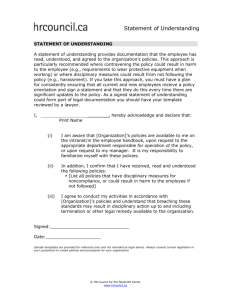
![Job Description - Program Director [1]](http://s3.studylib.net/store/data/005857458_1-3791b985859891a770a8c3867ad1e7d5-300x300.png)
